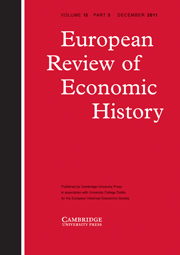Crossref Citations
This article has been cited by the following publications. This list is generated based on data provided by
Crossref.
Kelly, Morgan
and
O'Grada, Cormac
2009.
The Poor Law of Old England: Resource Constraints and Demographic Regimes.
SSRN Electronic Journal,
A'Hearn, Brian
and
Venables, Anthony J.
2011.
Internal Geography and External Trade: Regional Disparities in Italy, 1861-2011.
SSRN Electronic Journal,
Pfister, Ulrich
2011.
Enzyklopädie der Neuzeit.
p.
454.
Federico, Giovanni
and
Sharp, Paul Richard
2011.
The Cost of Railroad Regulation: The Disintegration of American Agricultural Markets in the Interwar Period.
SSRN Electronic Journal,
FEDERICO, GIOVANNI
2012.
How much do we know about market integration in Europe?1.
The Economic History Review,
Vol. 65,
Issue. 2,
p.
470.
Jaeger, Friedrich
2012.
Enzyklopädie der Neuzeit.
p.
451.
Federico, G.
2012.
The Corn Laws in continental perspective.
European Review of Economic History,
Vol. 16,
Issue. 2,
p.
166.
Mateus, Abel M.
2013.
Development Theory and Globalization: A Reinterpretation.
SSRN Electronic Journal,
Chilosi, David
Murphy, Tommy E.
Studer, Roman
and
Tunçer, A. Coşkun
2013.
Europe's many integrations: Geography and grain markets, 1620–1913.
Explorations in Economic History,
Vol. 50,
Issue. 1,
p.
46.
Sharp, Paul
and
Weisdorf, Jacob
2013.
Globalization revisited: Market integration and the wheat trade between North America and Britain from the eighteenth century.
Explorations in Economic History,
Vol. 50,
Issue. 1,
p.
88.
Ojala, Jari
Pehkonen, Jaakko
and
Eloranta, Jari
2013.
Desertions in nineteenth-century shipping: modelling quit behaviour.
European Review of Economic History,
Vol. 17,
Issue. 1,
p.
122.
Federico, Giovanni
and
Sharp, Paul
2013.
The cost of railroad regulation: the disintegration of American agricultural markets in the interwar period.
The Economic History Review,
Vol. 66,
Issue. 4,
p.
1017.
Uebele, M.
2013.
What Drives Commodity Market Integration? Evidence from the 1800s.
CESifo Economic Studies,
Vol. 59,
Issue. 2,
p.
412.
Vinnal, H.
2014.
The world refuses to shrink: the speed and reliability of information transmission in North and Baltic Sea region, 1750-1825.
European Review of Economic History,
Vol. 18,
Issue. 4,
p.
398.
Lampe, Markus
and
Sharp, Paul
2014.
Handbook of Cliometrics.
p.
1.
Brunt, Liam
and
Cannon, Edmund
2014.
Measuring integration in the English wheat market, 1770–1820: New methods, new answers.
Explorations in Economic History,
Vol. 52,
Issue. ,
p.
111.
Klovland, Jan Tore
2014.
Challenges for the Construction of Historical Price Indices: The Case of Norway, 1777-1920..
SSRN Electronic Journal,
Keller, Wolfgang
and
Shiue, Carol H.
2014.
Endogenous Formation of Free Trade Agreements: Evidence from the Zollverein's Impact on Market Integration.
The Journal of Economic History,
Vol. 74,
Issue. 04,
p.
1168.
Andersson, Fredrik N.G.
and
Ljungberg, Jonas
2015.
Grain Market Integration in the Baltic Sea Region in the Nineteenth Century.
The Journal of Economic History,
Vol. 75,
Issue. 3,
p.
749.
Uebele, Martin
and
Gallardo-Albarrán, Daniel
2015.
Paving the way to modernity: Prussian roads and grain market integration in Westphalia, 1821–1855.
Scandinavian Economic History Review,
Vol. 63,
Issue. 1,
p.
69.


